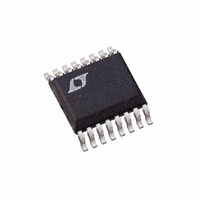LTC1435AIG#PBF Linear Technology, LTC1435AIG#PBF Datasheet - Page 8

LTC1435AIG#PBF
Manufacturer Part Number
LTC1435AIG#PBF
Description
IC SW REG SYNC STEP-DOWN 16-SSOP
Manufacturer
Linear Technology
Type
Step-Down (Buck)r
Datasheet
1.LTC1435ACSPBF.pdf
(20 pages)
Specifications of LTC1435AIG#PBF
Internal Switch(s)
No
Synchronous Rectifier
Yes
Number Of Outputs
1
Voltage - Output
1.19 ~ 9 V
Current - Output
50mA
Frequency - Switching
125kHz
Voltage - Input
3.5 ~ 30 V
Operating Temperature
-40°C ~ 85°C
Mounting Type
Surface Mount
Package / Case
16-SSOP
Lead Free Status / RoHS Status
Lead free / RoHS Compliant
Power - Output
-
Available stocks
Company
Part Number
Manufacturer
Quantity
Price
LTC1435A
APPLICATIONS
The value of C
frequency:
A graph for selecting C
2. As the operating frequency is increased the gate charge
losses will be higher, reducing efficiency (see Efficiency
Considerations). The maximum recommended switching
frequency is 400kHz.
Inductor Value Calculation
The operating frequency and inductor selection are inter-
related in that higher operating frequencies allow the use
of smaller inductor and capacitor values. So why would
anyone ever choose to operate at lower frequencies with
larger components? The answer is efficiency. A higher
frequency generally results in lower efficiency because of
MOSFET gate charge losses. In addition to this basic trade-
off, the effect of inductor value on ripple current and low
current operation must also be considered.
The inductor value has a direct effect on ripple current. The
inductor ripple current I
tance or frequency and increases with higher V
Accepting larger values of I
tances, but results in higher output voltage ripple and
8
C
OSC
I
L
( )
pF
f L
1
300
250
200
150
100
50
0
OSC
Figure 2. Timing Capacitor Value
0
V
Frequency (kHz)
OUT
is calculated from the desired operating
100
U
OPERATING FREQUENCY (kHz)
1.37(10 )
1–
OSC
200
INFORMATION
L
V
U
vs frequency is given in Figure
V
OUT
decreases with higher induc-
4
IN
L
allows the use of low induc-
300
400
W
–
11
1435A F02
500
IN
U
or V
OUT
:
greater core losses. A reasonable starting point for setting
ripple current is I
The inductor value also has an effect on low current opera-
tion. The transition to low current operation begins when
the inductor current reaches zero while the bottom MOSFET
is on. Lower inductor values (higher I
occur at higher load currents, which can cause a dip in
efficiency in the upper range of low current operation. In
Burst Mode operation, lower inductance values will cause
the burst frequency to decrease.
The Figure 3 graph gives a range of recommended induc-
tor values vs operating frequency and V
For low duty cycle, high frequency applications where the
required minimum on-time,
is less than 350ns, there may be further restrictions on the
inductance to ensure proper operation. See Minimum On-
Time Considerations section for more details.
Inductor Core Selection
Once the value for L is known, the type of inductor must be
selected. High efficiency converters generally cannot afford
the core loss found in low cost powdered iron cores, forc-
ing the use of more expensive ferrite, molypermalloy or Kool
M
Kool M is a registered trademark of Magnetics, Inc.
I
L
t
®
occurs at the maximum input voltage.
ON MIN
cores. Actual core loss is independent of core size for
(
)
Figure 3. Recommended Inductor Values
60
50
10
40
30
20
0
0
V
IN MAX
(
L
V
50
= 0.4(I
OUT
OPERATING FREQUENCY (kHz)
)
100
f
MAX
,
150
). Remember, the maximum
200
V
V
V
OUT
OUT
OUT
250
= 5.0V
= 3.3V
1435A F03
L
2.5V
) will cause this to
OUT
300
.













